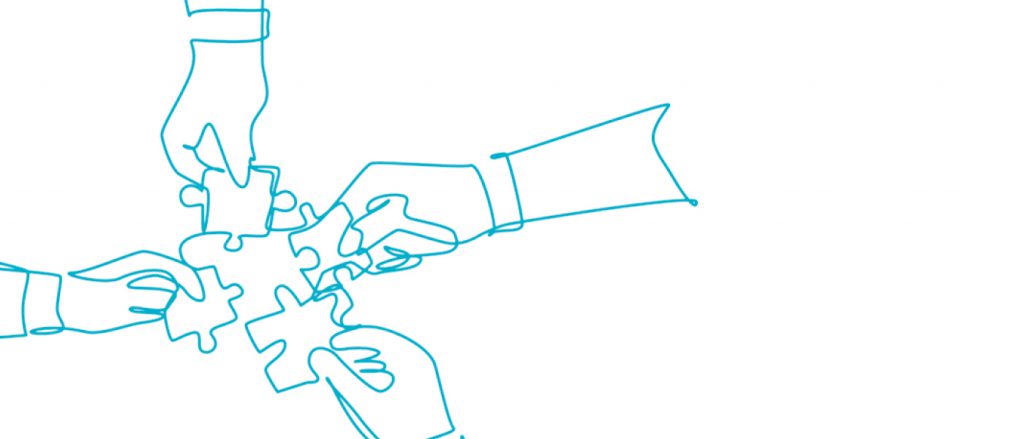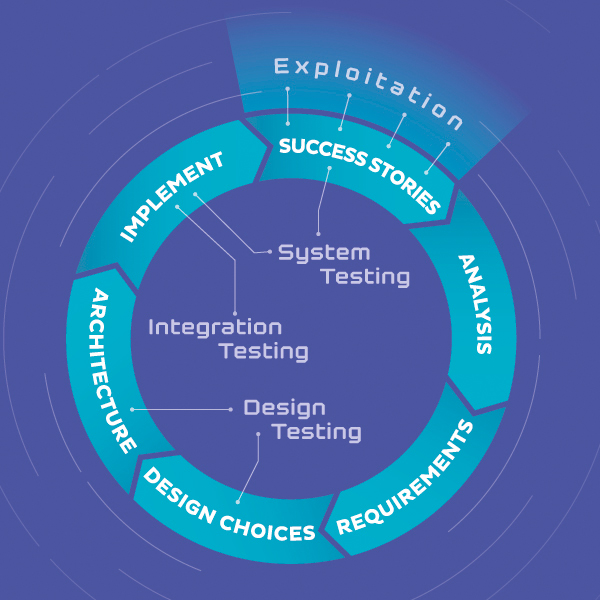
The project
Connecting Industry and Science
Mission Statement
An innovation platform for europe
OpenModel – Integrated Open Access Materials Modelling Innovation Platform for Europe. OpenModel aims to design, create, provide, and maintain a sustainable integrated open platform for innovation which delivers predictable, validated, and traceable simulation workflows integrating seamlessly third-party physics-based models, solvers, post-processors and databases.
OpenModel thus bridges the gap from industry challenge via translation to actionable results that enable well informed business decisions. Six use cases (Success Stories) show the applicability to a wide range of materials and their related processing technologies and demonstrate how OpenModel facilitates setting up experiments, reducing error and enhancing development efficiency.

Development
The OpenModel Agile Development Cycle
The Digital Single Market initiative (DSM) and the emerging activities within Industry 4.0 call for a deeper digitalisation of materials modelling and additional actions that allow materials modelling to be more usable and integrable with the overall digitalisation actions in Europe. The wider and enhanced use of modelling and digital twins is considered critical for more agile, efficient, and sustainable product development meeting ever more challenging and tailored requirements.
OpenModel will provide to European Industry a comprehensive, integrated open modelling framework for accelerated innovation processes and development of novel materials and products. Global competition requires European Industry to adopt advanced techniques to shorten development cycles for new products and materials. To address this, OpenModel will be built around Key Performance Indicators (KPIs) defined by industrial Success Stories. To maximize leverage, OpenModel builds on state-of-the-art European open simulation platform (OSP) technologies and is designed from the ground up to allow integration of any third-party solvers, data, models, pre- and post-processing tools into advanced workflows spanning all operations along the value chain.
OpenModel embraces existing and emerging standards for semantic interoperability based on the European Materials & Modelling Ontology (EMMO) enabling seamless integration with the Materials Modelling Market Places (MMMP) that provide the access to all necessary models, tools, expertise, and data that are necessary to populate the workflows with and to the HPC platforms to complete the offers to customers. OpenModel’s deep foundations in EMMO also supports the current developments towards a “common language” for materials modelling and characterization


Project structure
Nine steps to success
WP1 Cross Domain Semantic Interoperability Foundations
- Build the semantic foundations for the OpenModel OIP for seamless and standardised integration of third-party physics-based models, solvers, post-processors, and databases on a semantic basis facilitating the integration with NMBP-10-2019 Open Translation Environment developed by the OntoTRANS project.
- Identify technical requirements and KPI necessary for the representation and execution of workflows.
- Provide contributions to the development of a standardised ontological framework covering modelling, characterisation, materials processing and materials manufacturing.
- Contribute to EMMO middle-level and application-level ontology and interact with NMBP-39-2020 CSA Project OntoCommons.
WP2 Design and implementation of OIP core services
- Establish well adapted agile software engineering best practices and development tools.
- Design the common technical architecture of the entire platform based on semantic interoperability and ontology.
- Implement and provide core ontology-based interoperability components.
- Collect, integrate, deploy, and maintain the OpenModel OIP.
WP3 Standardised integration of third-party models and tools
- Provide avenues for seamless and standardised integration of third-party physics-based models, solvers, postprocessors and databases and data-based models.
- Develop and provide for the entire community an integration service for third party tools through software development kits (SDK) and tutorials.
- Develop a body of wrappers for facilitating the demonstration of the OPI platform and testing and enhancing the integration scheme.
- Implement interfaces supporting existing and emerging standards for semantic interoperability across domains, resulting in an open framework.
WP4 OIP Applications and Workflow Builders
- Development of novel semantic based OntoFlow workflow builder with BDSS support.
- Automated AI- and MCO-enhanced model and method selection for advanced workflows based on industry requirements.
- Provide advanced Validation and Verification services for materials modelling and data.
- Integration and Applications for BDSS systems.
WP5 Demonstration and Success Stories
- Collect the business perspective of all use cases to set use cases specific KPIs.
- Collect, analyse and document use cases specific data, models and workflows.
- Carry out preliminary executions on all use cases to provide a benchmark and ensure all aspect on OIP are covered for each use cases.
- Demonstrate the capabilities of the OpenModel OIP across multiple industrial sectors.
- Develop and apply contemporary integrated modelling workflows demonstrating the capabilities of the OIP.
- Demonstrate the capabilities of the OpenModel OIP with full functionality, integrating all components, including elaboration of options, decisions on workflows, performing simulations, generating new data, data analytics and results interpretation.
WP6 Dissemination and Exploitation
- Provide a strong and unique identity for OpenModel, identify and segment all stakeholders to communicate and disseminate results through relevant and effective channels.
- Manage innovations, IP, KERs and exploitation routes for all project outcomes.
- Provide education and training of relevant internal and external stakeholders to support uptake of OpenModel and tech transfer and support the change management that accompanies the introduction of such innovative technology.
- Elaborate a detailed understanding of needs, benefits and enabling changes at industrial end users to support the expected impacts of OpenModel as a requirement for OpenModel implementation.
- Draw up a detailed business plan and 12-month action plan for sustainability of OpenModel
WP7 Cooperation and Exchange
- To coordinate the integration of OpenModel applications and services into the MMMPs, in particular, facilitating the sourcing of all necessary models, tools, expertise and data.
- To coordinate cooperation with HPC platforms to facilitate execution of workflows.
- To coordinate a collaborative demonstration with relevant initiatives (OTE, MMMP and HPCs) to demonstrate a complete end-to-end solution.
- To build and foster strong cooperation with stakeholders from marketplaces, OTE, ITB, business collaborations and possible OpenModel users.
- To coordinate with characterisation networks to facilitate setting up experiments
- To interact strongly with IndustryCommons initiatives via OntoCommons CSA, in particular, to coordinate and contribute to the development of specifications for common interoperability, emerging standards, harmonisation of existing (sub-domain) ontologies.
WP8 Coordination
- To identify and confirm deliverables, milestones, staff levels, materials, external costs, travel, depreciation of capital items and likely meeting schedules for the partnership.
- To coordinate and conduct the project according to the work plan.
- To ensure efficient and high-quality communication between the partners.
- To ensure a smooth transfer of information (e.g., reports) to and from the Commission.
- To distribute the financial support paid by the Commission among the partners.
- To perform risk management, including identification and assessment of risks over the entire duration of the project.
WP9 Ethics requirements
- This work package sets out the ‚ethics requirements‘ that the project must comply with.
